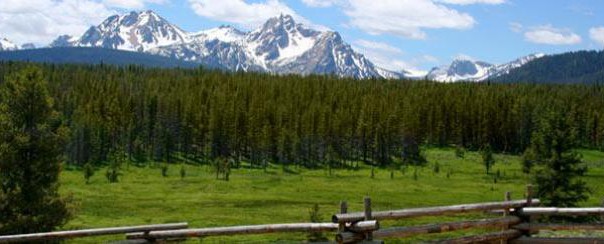Sustainability and Certification Scams
National and Idaho forest lands are governed by federal laws, the United States Forest Service (USFS), and the Idaho Forest Practice Act (IFPA). But how can corporations and private land owners prove they are being responsible forest managers. Who is going to “monitor” them like the government lands are? Certification schemes, that’s how. Certification programs are “voluntary” but the public has been led to believe that a piece of wood coming from a “certified forest” has somehow been more properly managed so there is considerable pressure for family forest owners and forest industry companies to become certified.
There are two major certification organizations in the U.S., the Forest Stewardship Council (FSC) and the Sustainable Forestry Initiative (SFI). There are others but these are the primary programs. Certification requires certain forest management standards are met which implies the forest is being managed “sustainably”. Although they use different standards, and even fight between themselves, both promote “sustainable” forest management. If a corporation or family forest owner is “certified” one could be lead to believe that somehow they are practicing more responsible forestry. There is much disagreement between these two organizations.
The FSC was formed by environmentalists and European industry leaders in 1994, headquartered in Mexico, and has members worldwide including Idaho. FSC has 10 principles it operates under, several of which are similar to the USFS such as assessing environmental impact, developing a plan, and monitoring the plan. They claim private land owners, if certified, are better at “protecting” forests, having a special category for “Family Forests”. Boasting about its Gold Standard for Forest Management, some practices include limited clearcutting, protecting old growth, and restricting forest conversion. Every log is tracked by Chain of Custody (COC) and kept separate from “non-certified” material, however non-certified material can be mixed with certified material called controlled wood. Forest Management Certification requires adherence to standards that are as restrictive as USFS regulations and can be found under the US Forest Management link. Of course there is a cost (North stands for wealthy countries, South for poor) to become certified but you can also get a group certification for cost sharing. Those costs are passed on to you, the consumer, when you buy FSC products. You can recognize FSC products by its label. In general FSC is heavily supported by environmental groups.
SFI was also launched in 1994, similar to FSC in that it has a COC, has 15 management standards similar to the FSC principles with a guide to implement them, and promotes “sustainable forest management.” SFI partners with major corporations to promote their cause. Although there is “no fee for COC certification” obtaining COC certification involves a “body” which conducts an audit for $2,000 to $3,000 per site with annual renewal required. Again, this cost is passed on to the consumer when SFI products are purchased which can be identified by their labels. FSC is global and SFI is in “North America” as noted on this FSC/SFI comparison sheet by SFI. As two examples in Idaho, Boise Cascade is SFI Wood Products certified and Idaho Forest Group is SFI COC certified.
Another voluntary certification program, the Idaho Tree Farm Program (ITFP), an affiliate of the American Tree Farm System (ATFS), promotes “better forest management among nonindustrial forest owners”, preferably known as family forest owners. ATFS just came out with new 2015-2020 standards that require a plan that accounts for forest species; protection from fire, pests, disease, and destructive grazing; reforestation; harvesting for sustained yield; and the requirement that all federal laws are followed. One goal of the State committee for ITFP is to, “Establish and maintain standards and procedures for Idaho lands, certified under the American Tree Farm System.”
The Programme for the Endorsement of Forest Certification (PEFC) is an organization that endorses forest certification systems (except national forests) with its own logo. SFI and ATFS, Boise Cascade, Potlatch, and Idaho Forest Group are PEFC certified. PEFC has standards, believes private land owners should be certified to prove they are “demonstrating respect” for their land, and comply with “internationally benchmarked” standards. Idaho forest owners voluntarily meeting “international” standards, in addition to Idaho state required standards.
There is also a “certification” for foresters through the Society of American Foresters (SAF), established in 1994, and again “voluntary”. Standards include following all regulations on environmental quality and management of forest resources.
All of the federal laws, regulations, and certification programs sound important for protecting forests. Promotion and protection of the “ecosystem”, “habitat”, “cultural”, and “biodiversity” really does sound like the right thing to do. But, stop and think. If these protections weren’t there 60 years ago then why were those same forest attributes still present when the environmentalists decided they needed protecting? Wouldn’t they have disappeared, especially from all the “harm” being caused by man? They didn’t because the forest has the breathtaking ability to regenerate itself. As a renewable resource it is our responsibility to help the forest regenerate, not set it aside for “preservation” whether by making it untouchable or creating rules that are illogical attempts to leave it in the same state at any given moment in time. Forests are living, breathing, and evolving miracles on their own without humanity trying to outsmart Mother Nature, man will never be smarter than her.
Natural habitat should be protected when harvesting forest resources, as much as possible nature should be left in the same shape as when it was disturbed to promote regeneration, much needed watersheds should be protected from damage, forest management should continue in a way that wildlife can continue to thrive, and we should be held accountable for enjoying recreational activities without forest harm. There is nothing wrong with any of this. But, the hidden agenda and the true managers of the forest, who most are not aware of, will be discussed in Part 4.


